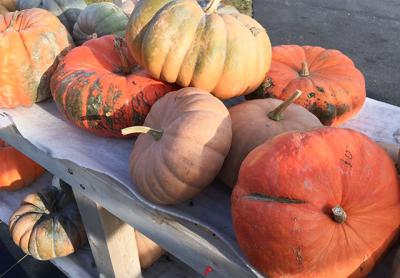Seasons by the Sea: Pumpkins? Say Cheese!

I first learned about Long Island cheese pumpkins about 23 years ago. I was working as a pastry chef somewhere out here, and it was that time of year, the time of year that I would have to crank out many, many pumpkin pies. So I started working on my supply list: industrial quantities of Libby’s canned pumpkin, cinnamon, cloves, ginger, nutmeg, lotsa eggs. And then the head chef presented me with a crate full of pretty, pale, squat pumpkins, a variety I had never seen before. He had to seek them out at one of the very few farms on the East End that still grew this interesting specimen.
“Will it really make a difference?” I wondered. After all, canned pumpkin, any pumpkin, is fairly bland and innocuous until you add all the spices and bake it into a flaky crust.
Yes, it made a difference!
This particular variety of Cucurbita moschata is one of the oldest cultivated in America, and is especially well suited for growing on Long Island. In the 1800s, local cookbooks and farmers’ almanacs often cited the cheese pumpkin, or “pie squash,” as being the best for “making the most delicious of Yankee notions — pumpkin pie,” according to an issue of “Michigan Farmer” from 1855.
One of the reasons this pumpkin almost became extinct was its shape. Farmers desired a pumpkin that was round and agreeable to rolling politely off a conveyor belt, so such varieties as Dickinson and Kentucky Field became more popular. The squat shape and deeply ribbed surface of the cheese pumpkin also made it harder to peel. Ken Ettlinger, a local seed saver and natural science educator, began to notice in the 1970s that this pumpkin, along with other heirloom varieties, was starting to disappear. With help and support from the Northeast Organic Farmers Association, Cornell Cooperative Extension, and others, he was able to revive this variety enough for a few seed companies like Johnny’s Selected Seeds and Seed Savers Exchange to begin carrying them.
Why is it called “cheese” pumpkin? Apparently because it resembles a big wheel of cheese. But inside, the flesh is denser, sweeter, and less stringy and watery than the “pepo,” the bright orange Halloween pumpkin we are used to seeing everywhere. The flesh itself has more nutrients and beta carotene, and is similar to butternut squash, a close relative. You can eat the whole thing, seeds, skin, and flesh. Just be sure to scrub well if you intend to eat with the skin on, because all fruits and vegetables that grow on the ground are likely to come in contact with birds and deer and bunnies doing their business out in the field.
Some recipes suggest boiling cubes of the pumpkin or microwaving it. I would recommend roasting before continuing with a recipe. If you’ve ever tasted the difference between a boiled beet and a roasted beet, you will understand. Roasting keeps in all the sugars and gives more depth of flavor. If you have a microwave, which I do not, then this method sounds like a good and faster alternative.
Another distinguishing characteristic of the cheese pumpkin is that it holds its shape if you want to incorporate it in cubes into stews or soups (that are not pureed).
Besides pies, you can add this pumpkin to risottos, make raviolis with fresh lasagna sheets or wonton wrappers, and top with sage-infused brown butter sauce. Puree it into a thick soup with ginger and coconut milk. Roast the seeds with some harissa, brown sugar, and a bit of oil.
There is now a Long Island Cheese Pumpkin Project, which pledges to “grow, revitalize, and preserve the culinary use of this heirloom squash.” Among its many ambassadors are the North Fork Table and Inn, the Amagansett Food Institute, the Milk Pail in Water Mill, and several Edible School gardens on both the North and South Forks.
The Long Island cheese pumpkin is now, thankfully, easier to find that it was many years ago when I first met this homely, yet somehow attractive blob of a squash. I strongly urge you to seek one out, either for your holiday pies or a warming fall soup, stew, risotto, you name it. I am going to try it stuffed and roasted a la Dorie Greenspan’s recipe from a friend in Lyons. For recipe inspiration, just think butternut squash; anything you can do with a butternut squash, you can do with a cheese pumpkin. Here are some ideas to get you started.
Click for recipes
